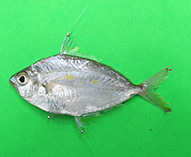| Family: |
Leiognathidae (Slimys, slipmouths, or ponyfishes), subfamily: Gazzinae |
| Max. size: |
12.79 cm SL (male/unsexed) |
| Environment: |
demersal; marine; depth range 0 - 86 m |
| Distribution: |
Western Pacific: Philippines, Malaysia, Indonesia, Australia. . |
| Diagnosis: |
Dorsal spines (total): 8-8; Dorsal soft rays (total): 16-16; Anal spines: 3-3; Anal soft rays: 14-14; Vertebrae: 23-23. The males of this species are distinguished from all its congeners by possessing an expansive cornucopia-shaped translucent lateral flank patch, while both sexes can be further distinguished from P. elongatus and P. rivulatus, by the more or less bullet-shaped flank patch; a deeper body 34.4-39.2 (vs. 12.5-29.7% of SL); and, vermiculate pigmentation pattern on the upper flank with thin wavy lines forming semi-circles and oval shapes (vs. larger rounded blotches). Both sexes of this species differ from P. leuciscus and P. klunzingeri, by the triangular flank patch; absence of a markedly elongate second dorsal-fin spine; and the vermiculate pigmentation pattern on the upper flank, with thin wavy lines forming semi-circles and oval shapes (vs. speckled). Adults of both sexes of also grow to a larger size than congeners, except P. leuciscus (Ref. 59114). |
| Biology: |
|
| IUCN Red List Status: |
Data deficient (DD); Date assessed: 15 September 2009 Ref. (130435)
|
| Threat to humans: |
harmless |
| Country info: |
Type locality, Samar Sea, Carigara Bay, 0-86 m, USNM 387899 (holotype of Photoplagios laterofenestra, 11.52 cm SL) (Ref. 59114). Also Ref. 120651. |
Source and more info: www.fishbase.org. For personal, classroom, and other internal use only. Not for publication.

